Raman Microscopic Identification of Microorganisms on Metal Surfaces via Support Vector Machines
Abstract
:1. Introduction
2. Materials and Methods
2.1. Growth Conditions and Sample Preparation
2.2. Spectral Recording
2.3. Data Preprocessing
3. Results and Discussion
3.1. Comparison of Different Substrates on the Effects of Raman Spectra of Bacteria
3.2. Pretreated Raman Spectra of Microorganisms on Silver Mirror Slide
3.3. Model Development
3.4. Predictions for Independent Raman-Spectra of Microorganisms on Stainless Steel Slides
4. Conclusions
Author Contributions
Funding
Conflicts of Interest
References
- Tung, P.-Y.; Blischak, J.D.; Hsiao, C.J.; Knowles, D.A.; Burnett, J.E.; Pritchard, J.K.; Gilad, Y. Batch effects and the effective design of single-cell gene expression studies. Sci. Rep. 2017, 7, 39921. [Google Scholar] [CrossRef] [PubMed] [Green Version]
- Kang, D.-K.; Ali, M.M.; Zhang, K.; Huang, S.S.; Peterson, E.; Digman, M.A.; Gratton, E.; Zhao, W. Rapid detection of single bacteria in unprocessed blood using Integrated Comprehensive Droplet Digital Detection. Nat. Commun. 2014, 5, 5427. [Google Scholar] [CrossRef] [PubMed] [Green Version]
- Rösch, P.; Harz, M.; Krause, M.; Popp, J. Fast and reliable identification of microorganisms by means of Raman spectroscopy. In Biophotonics; Optics in Life Science; Optical Society of America: Washington, DC, USA, 2007; pp. 6633–6645. [Google Scholar]
- Pahlow, S.; Meisel, S.; Cialla-May, D.; Weber, K.; Rösch, P.; Popp, J. Isolation and identification of bacteria by means of Raman spectroscopy. Adv. Drug Deliv. Rev. 2015, 89, 105–120. [Google Scholar] [CrossRef] [PubMed]
- Stöckel, S.; Kirchhoff, J.; Neugebauer, U.; Rösch, P.; Popp, J. The application of Raman spectroscopy for the detection and identification of microorganisms. J. Raman Spectrosc. 2016, 47, 89–109. [Google Scholar] [CrossRef]
- Maquelin, K.; Kirschner, C.; Choo-Smith, L.-P.; Braak, N.V.D.; Endtz, H.; Naumann, D.; Puppels, G. Identification of medically relevant microorganisms by vibrational spectroscopy. J. Microbiol. Methods 2002, 51, 255–271. [Google Scholar] [CrossRef]
- Ho, C.-S.; Jean, N.; Hogan, C.A.; Blackmon, L.; Jeffrey, S.S.; Holodniy, M.; Banaei, N.; Saleh, A.A.E.; Ermon, S.; Dionne, J. Rapid identification of pathogenic bacteria using Raman spectroscopy and deep learning. Nat. Commun. 2019, 10, 1–8. [Google Scholar] [CrossRef] [PubMed]
- Yang, H.; Irudayaraj, J. Rapid detection of foodborne microorganisms on food surface using Fourier transform Raman spectroscopy. J. Mol. Struct. 2003, 646, 35–43. [Google Scholar] [CrossRef]
- Meisel, S.; Stöckel, S.; Elschner, M.; Melzer, F.; Rösch, P.; Popp, J. Raman Spectroscopy as a Potential Tool for Detection of Brucella spp. in Milk. Appl. Environ. Microbiol. 2012, 78, 5575–5583. [Google Scholar] [CrossRef] [PubMed] [Green Version]
- Rösch, P.; Harz, M.; Schmitt, M.; Peschke, K.-D.; Ronneberger, O.; Burkhardt, H.; Motzkus, H.-W.; Lankers, M.; Hofer, S.; Thiele, H.; et al. Chemotaxonomic Identification of Single Bacteria by Micro-Raman Spectroscopy: Application to Clean-Room-Relevant Biological Contaminations. Appl. Environ. Microbiol. 2005, 71, 1626–1637. [Google Scholar] [CrossRef] [PubMed] [Green Version]
- Strola, S.A.; Baritaux, J.-C.; Schultz, E.; Simon, A.C.; Allier, C.; Espagnon, I.; Jary, D.; Dinten, J.-M. Single bacteria identification by Raman spectroscopy. J. Biomed. Opt. 2014, 19, 111610. [Google Scholar] [CrossRef] [PubMed]
- Mikoliunaite, L.; Rodriguez, R.D.; Sheremet, E.; Kolchuzhin, V.; Mehner, J.; Ramanavicius, A.; Zahn, D.R. The substrate matters in the Raman spectroscopy analysis of cells. Sci. Rep. 2015, 5, 13150. [Google Scholar] [CrossRef] [PubMed] [Green Version]
- Hetjens, B.T.; Tewes, T.J.; Platte, F.; Wichern, F. The application of Raman spectroscopy in identifying Metarhizium brunneum, Metarhizium pemphigi and Beauveria bassiana. Biocontrol Sci. Technol. 2021, 1–12. [Google Scholar] [CrossRef]
- De Gelder, J.; De Gussem, K.; Vandenabeele, P.; Moens, L. Reference database of Raman spectra of biological molecules. J. Raman Spectrosc. 2007, 38, 1133–1147. [Google Scholar] [CrossRef]
- Chang, W.-C. On Using Principal Components Before Separating a Mixture of Two Multivariate Normal Distributions. J. R. Stat. Soc. Ser. C Appl. Stat. 1983, 32, 267. [Google Scholar] [CrossRef]
- Oliveira, F.S.; Giana, H.E.; Silveira, J.L. Discrimination of selected species of pathogenic bacteria using near-infrared Raman spectroscopy and principal components analysis. J. Biomed. Opt. 2012, 17, 107004. [Google Scholar] [CrossRef] [PubMed]
- Kampe, B.; Rösch, P.; Popp, J. Characterization of carotenoids in soil bacteria and investigation of their photodegradation by UVA radiation via resonance Raman spectroscopy. Analyst 2015, 140, 4584–4593. [Google Scholar] [CrossRef]
- Stöckel, S.; Meisel, S.; Elschner, M.; Rösch, P.; Popp, J. Identification of Bacillus anthracis via Raman Spectroscopy and Chemometric Approaches. Anal. Chem. 2012, 84, 9873–9880. [Google Scholar] [CrossRef] [PubMed]
- Yu, S.; Li, X.; Lu, W.; Li, H.; Fu, Y.V.; Liu, F. Analysis of Raman Spectra by Using Deep Learning Methods in the Identification of Marine Pathogens. Anal. Chem. 2021, 93, 11089–11098. [Google Scholar] [CrossRef] [PubMed]
- Zhang, J.; Suo, Y.; Zhang, D.-F.; Jin, F.; Zhao, H.; Shi, C. Genetic and Virulent Difference Between Pigmented and Non-pigmented Staphylococcus aureus. Front. Microbiol. 2018, 9, 598. [Google Scholar] [CrossRef] [PubMed]
- Schuster, K.C.; Reese, I.; Urlaub, E.; Gapes, J.R.; Lendl, B. Multidimensional Information on the Chemical Composition of Single Bacterial Cells by Confocal Raman Microspectroscopy. Anal. Chem. 2000, 72, 5529–5534. [Google Scholar] [CrossRef] [PubMed]
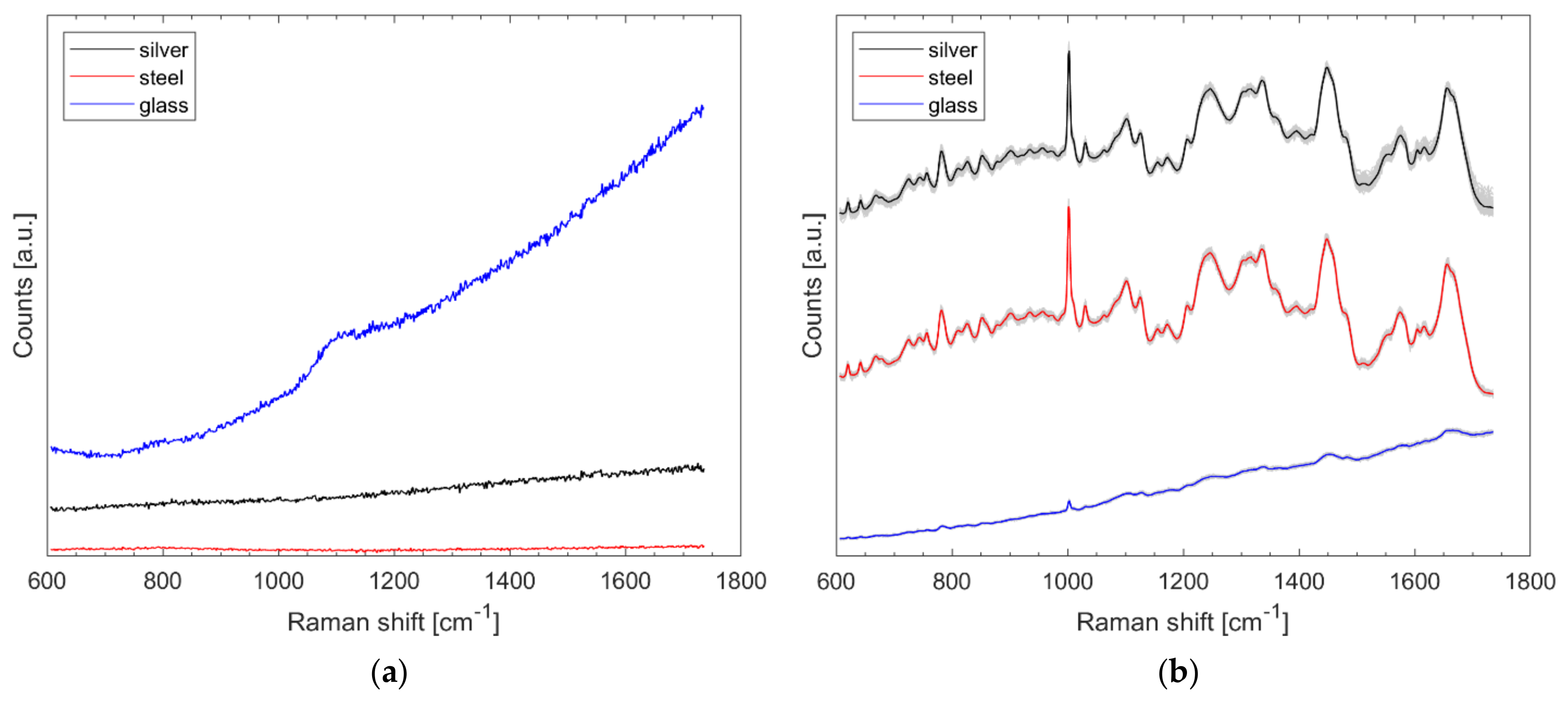
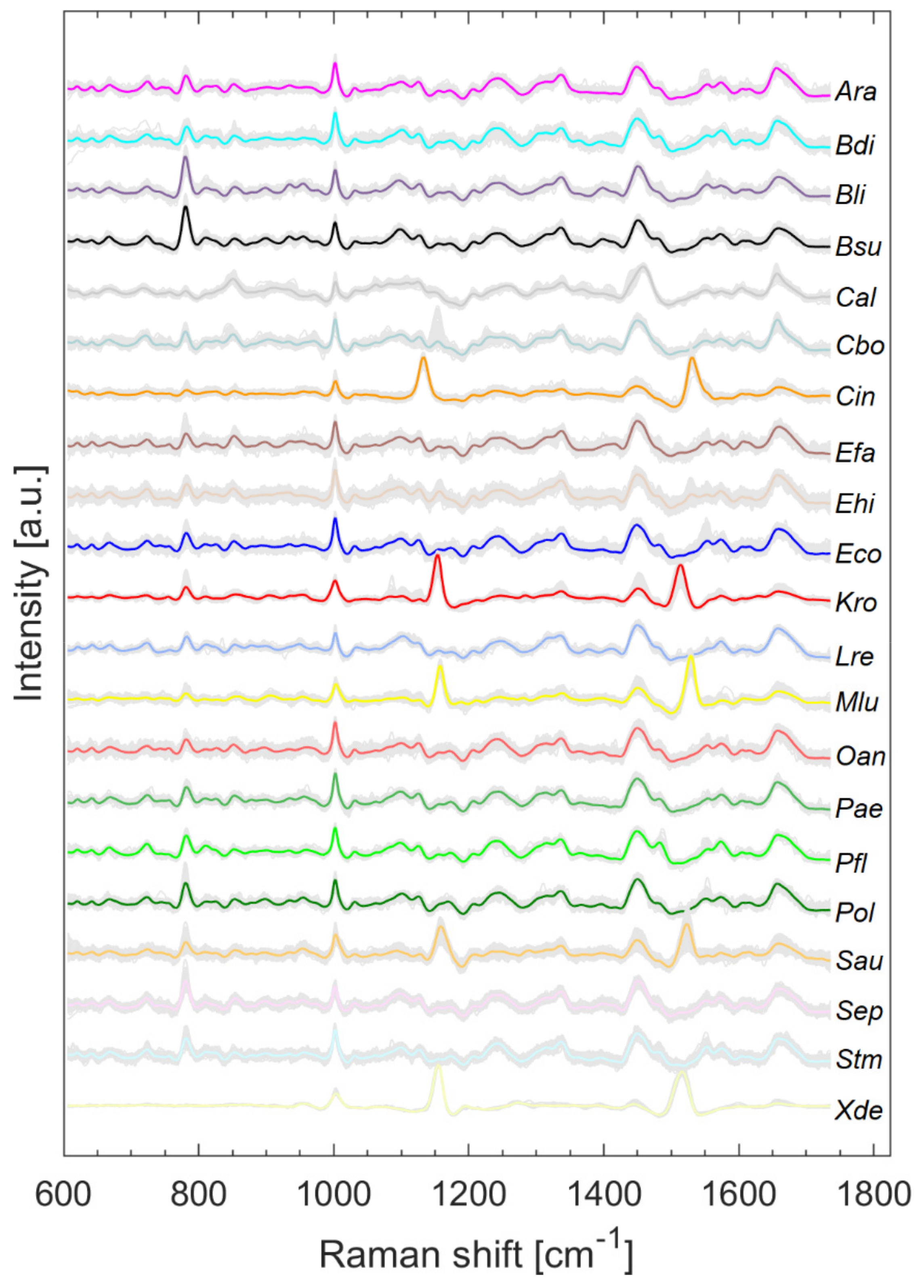
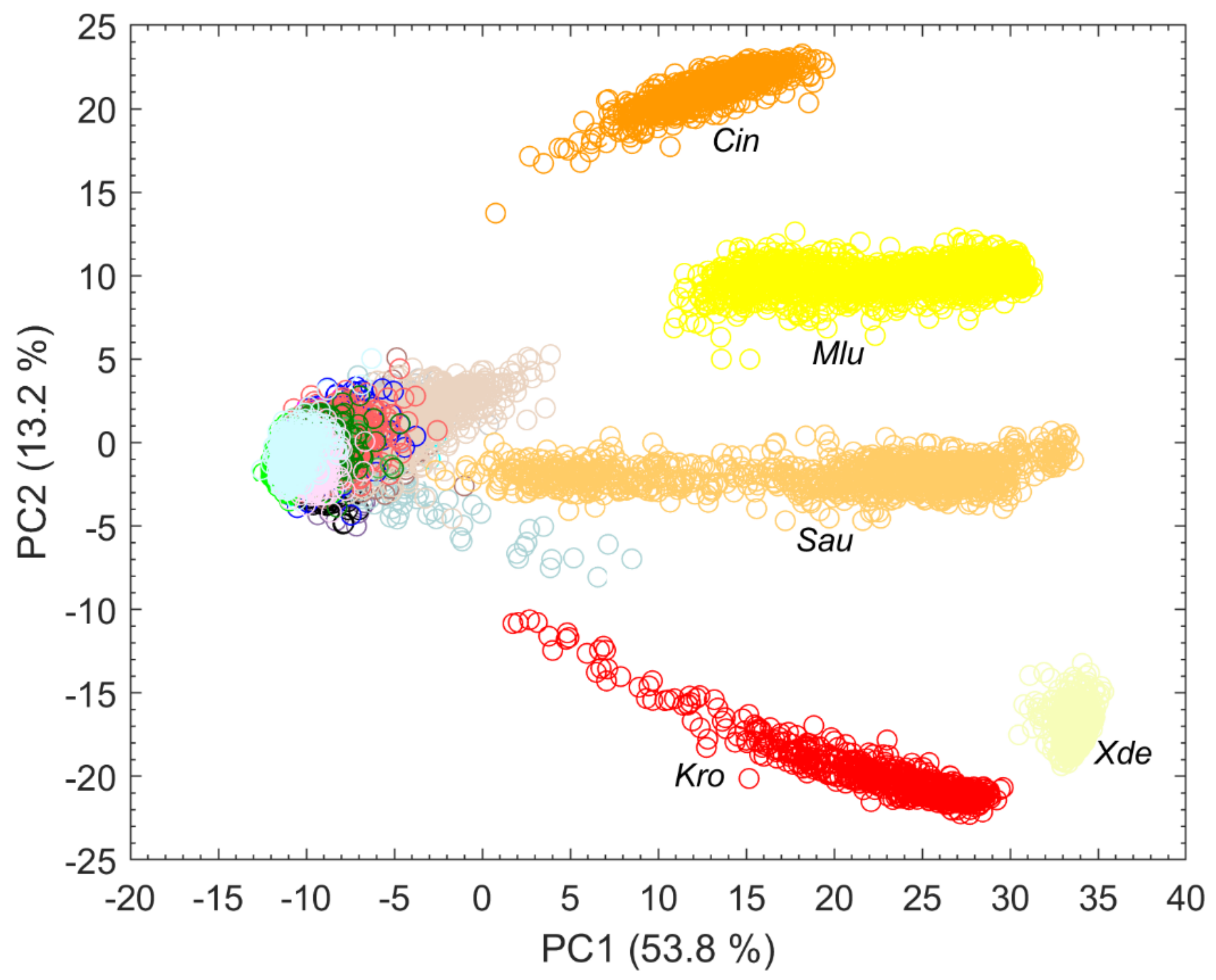
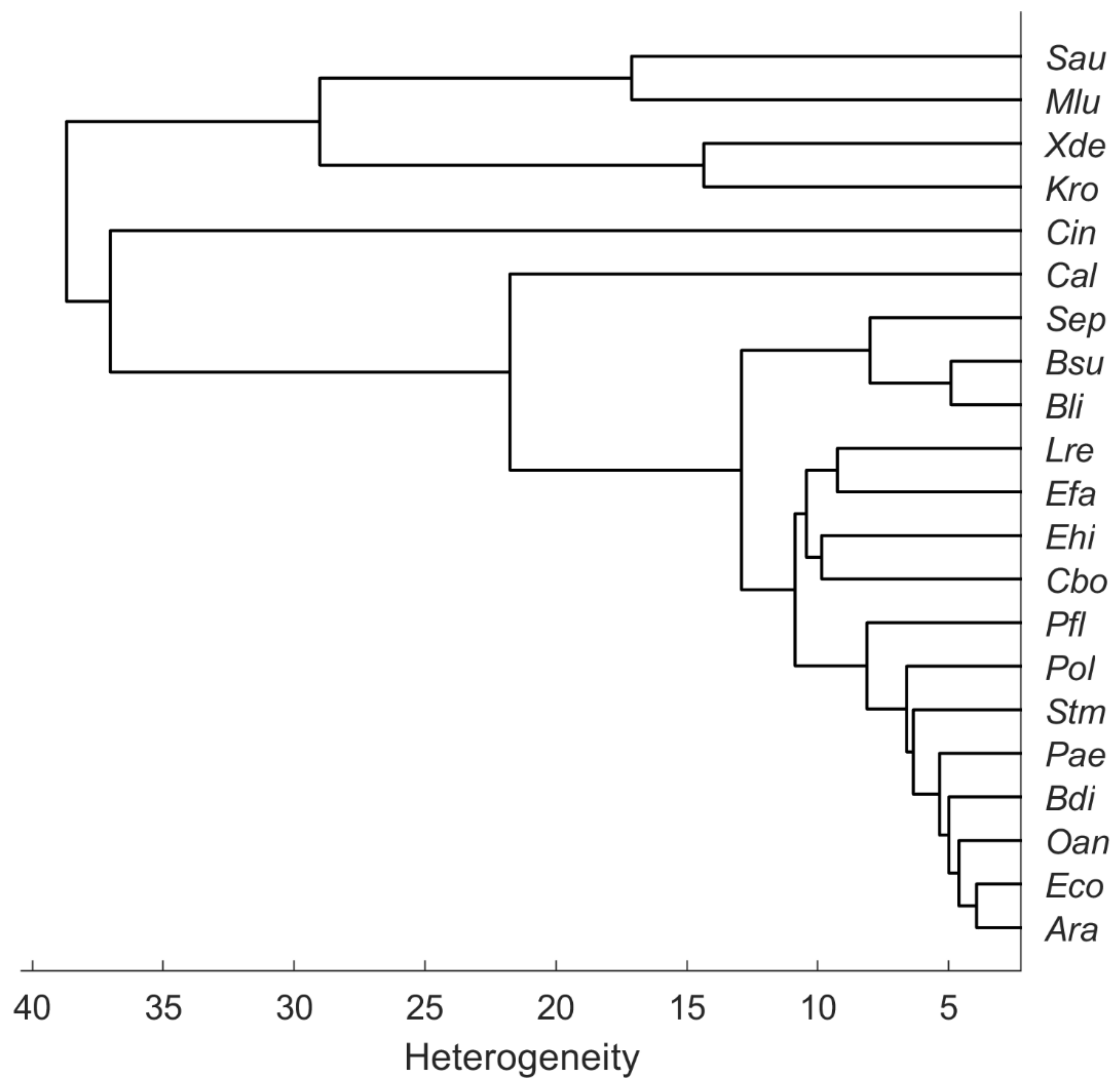

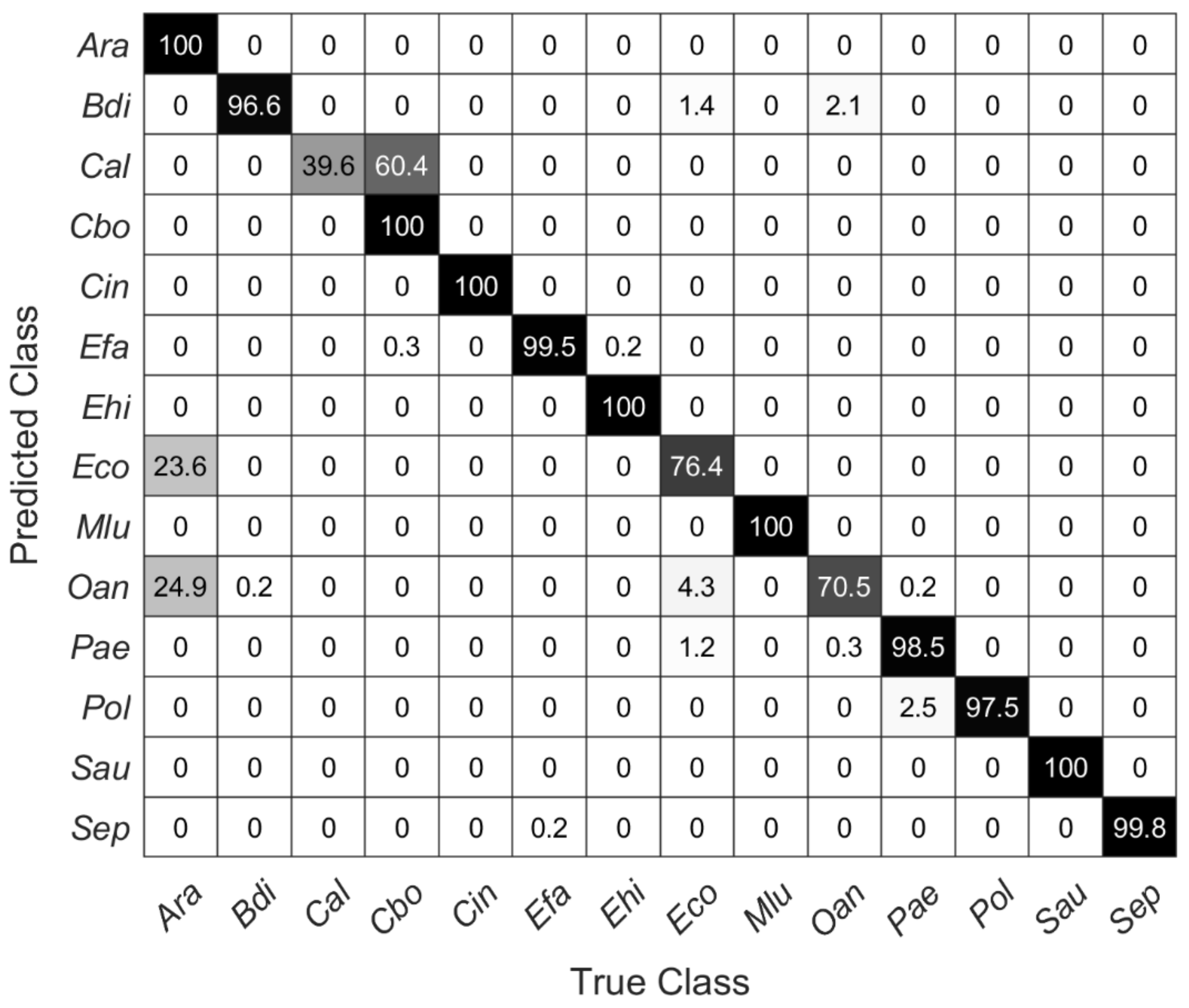

| Microorganism | Abbreviation | DSM-No. | Spectra | Independent Cultures | Exposure Time (Seconds); Accumulations | Nutrition Media | Cultivation Time |
|---|---|---|---|---|---|---|---|
| Acinetobacter radioresistens | Ara | 6976 | 725 | 1 | 1.5; 20 | TSA | 24 h |
| Brevundimonas diminuta | Bdi | 7234 | 897 | 3 | |||
| Bacillus licheniformis | Bli | 13 | 1240 | 2 | |||
| Bacillus subtilis | Bsu | 10 | 790 | 1 | |||
| Candida albicans | Cal | 1386 | 400 | 1 | MEA | ||
| Candida boidinii | Cbo | 70,034 | 686 | 1 | |||
| Chryseobacterium indolgenes | Cin | 16,777 | 684 | 1 | 1.5; 15 | TSA | |
| Enterococcus faecium | Efa | 2146 | 680 | 2 | 1.5; 20 | ||
| Enterococcus hirae | Ehi | 3320 | 1423 | 2 | |||
| Escherichia coli | Eco | 423 | 1190 | 3 | |||
| Kocuria rosea | Kro | own isolate | 639 | 1 | 1.5; 15 | ||
| Lactobacillus reuteri | Lre | 20015 | 420 | 1 | 1.5; 20 | 48 h | |
| Micrococcus luteus | Mlu | 1790 | 1842 | 6 | 1.5; 15 | 24 h | |
| Ochrobactrum anthropi | Oan | 6882 | 1045 | 2 | 1.5; 20 | ||
| Pseudomonas aeruginosa | Pae | 939 | 385 | 1 | |||
| Pseudomonas fluorescens | Pfl | 50,090 | 654 | 1 | |||
| Pseudomonas oleovorans subsp lubricantis | Pol | 21,016 | 632 | 1 | |||
| Staphylococcus aureus | Sau | 799 | 1094 | 3 | 1.5; 15 | ||
| Staphylococcus epidermidis | Sep | 1798 | 1111 | 2 | 1.5; 20 | ||
| Stenotrophomonas maltophilia | Stm | 50,170 | 460 | 1 | 1.5; 20 | ||
| Xanthophyllomyces dendrorhous | Xde | 5626 | 658 | 1 | 1.5; 15 | MEA |
| Number of used PCs for SVM | 10 | 11 | 12 | 13 | 14 | 15 | 16 | 17 | 18 | 19 | 20 |
| Estimated prediction accuracy in % | 94.3 | 94.6 | 95 | 95.6 | 96.1 | 97.2 | 97.4 | 97.8 | 98 | 98.2 | 98.4 |
| Number of used PCs for SVM | 10 | 11 | 12 | 13 | 14 | 15 | 16 | 17 | 18 | 19 | 20 |
| Validated prediction accuracy in % | 72.8 | 64.6 | 62.3 | 70.7 | 70 | 72.8 | 73.9 | 72.2 | 72.9 | 73.8 | 80.1 |
Publisher’s Note: MDPI stays neutral with regard to jurisdictional claims in published maps and institutional affiliations. |
© 2022 by the authors. Licensee MDPI, Basel, Switzerland. This article is an open access article distributed under the terms and conditions of the Creative Commons Attribution (CC BY) license (https://creativecommons.org/licenses/by/4.0/).
Share and Cite
Tewes, T.J.; Kerst, M.; Platte, F.; Bockmühl, D.P. Raman Microscopic Identification of Microorganisms on Metal Surfaces via Support Vector Machines. Microorganisms 2022, 10, 556. https://doi.org/10.3390/microorganisms10030556
Tewes TJ, Kerst M, Platte F, Bockmühl DP. Raman Microscopic Identification of Microorganisms on Metal Surfaces via Support Vector Machines. Microorganisms. 2022; 10(3):556. https://doi.org/10.3390/microorganisms10030556
Chicago/Turabian StyleTewes, Thomas J., Mario Kerst, Frank Platte, and Dirk P. Bockmühl. 2022. "Raman Microscopic Identification of Microorganisms on Metal Surfaces via Support Vector Machines" Microorganisms 10, no. 3: 556. https://doi.org/10.3390/microorganisms10030556






